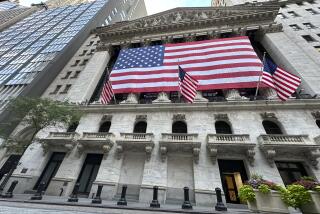Operating Level for May Edges Up, Hits 8-Year High
- Share via
WASHINGTON — U.S. industry operated at the highest level in more than eight years in May, the government said Thursday, but overall capacity use has not yet reached a level economists say would clearly fuel inflation.
The Federal Reserve Board said U.S. factories, mines and utilities operated at 82.9% of capacity in May, a 0.2 percentage point increase over April.
In a separate report Thursday, the Commerce Department said business sales fell 0.2% in April after strong increases in the previous two months. Inventories of goods held on shelves and back lots rose a moderate 0.5% in April, following a 0.3% increase in March.
The higher operating rate for May reflected the sixth increase in eight months and was the highest level since March, 1980, when the rate hit 83.7%. Operating rates rose by 0.3 percentage points in April, after dropping 0.1% in February and remaining unchanged in March.
Analysts had expected the modest rise in overall operating rates in May after the Federal Reserve reported Wednesday that production levels among U.S. industries had increased 0.4%.
Some economists are expressing concern that the upward creep will push prices higher as manufacturers have difficulty producing enough to meet demand.
But others say the May report is good news because operating rates cooled in the hottest industries and increased in sectors with excess capacity.
“A lot of people focus on a few industries and extrapolate from that and say we’re facing inflationary bottlenecks,” said Lawrence Chimerine, chairman of the Wefa Group, a Philadelphia-area forecasting firm. “That’s not true. Generally speaking, capacity rates are not that high.”
The May level of 82.9% was 3 percentage points higher than the 79.9% rate a year ago, but analysts generally do not consider the overall operating rate to be inflationary until it reaches 85%.
Rising capacity levels have been attributed to the surge in exports caused by the devaluation of the dollar.
But so far consumer demand in the United States appears to have been restrained enough to allow manufacturers in most industries to meet both domestic and foreign demand comfortably.
The Commerce Department, meanwhile, said inventories climbed to a seasonally adjusted $723.7 billion in April. The gain came as total business sales fell to a seasonally adjusted $478.8 billion.
Economists generally take rising inventories as a sign that buying demand is slowing and as an indication that manufacturers may have to cut back production.
Chimerine said April inventory growth was “slightly disturbing” and would be “a real source of concern” if it continued.
But he said he expected smaller growth in the months ahead and did not foresee a return to the high rate of inventory expansion from October to January, when monthly increases ranged from 0.7% to 1.2%.
More to Read
Inside the business of entertainment
The Wide Shot brings you news, analysis and insights on everything from streaming wars to production — and what it all means for the future.
You may occasionally receive promotional content from the Los Angeles Times.










